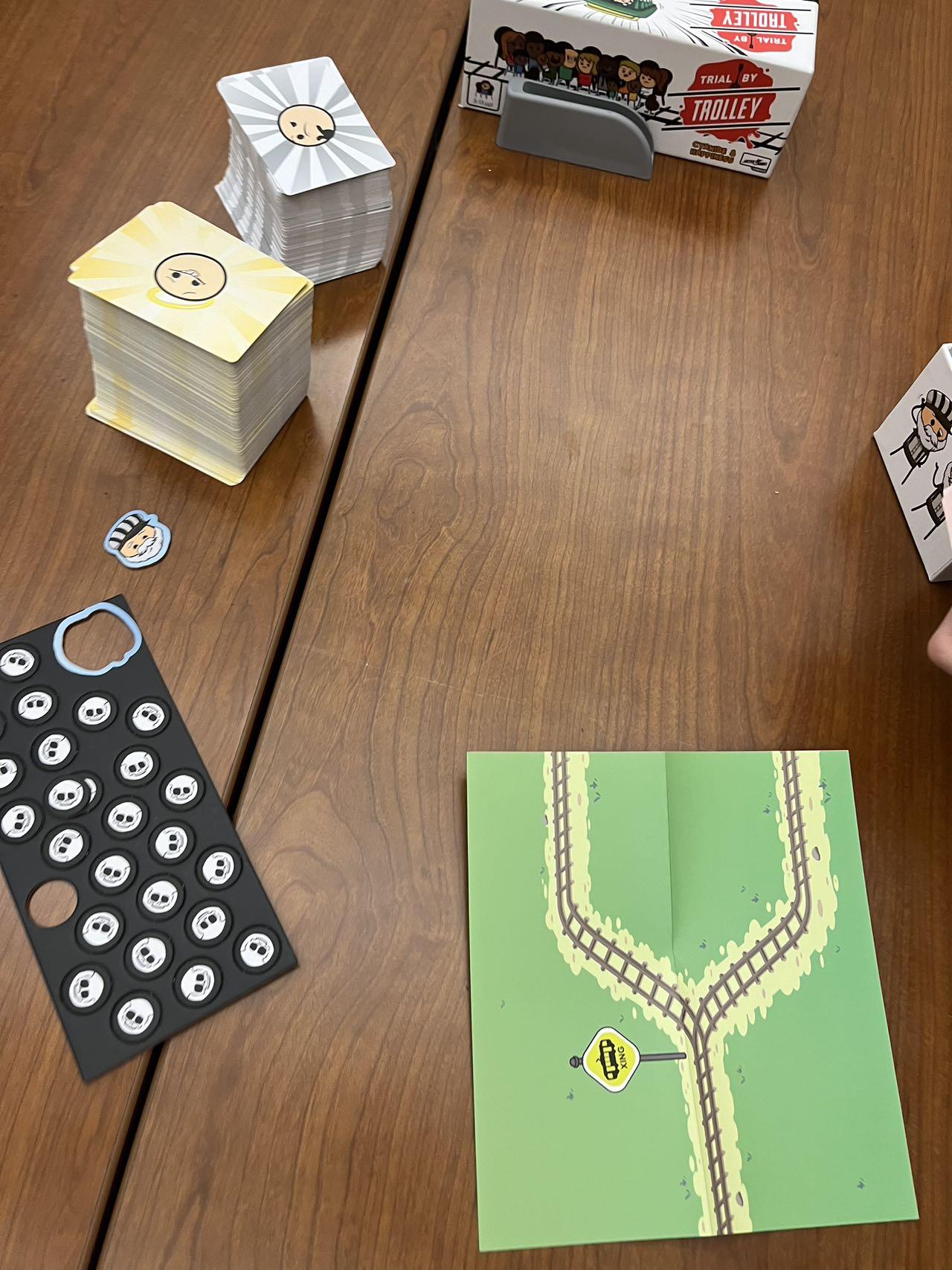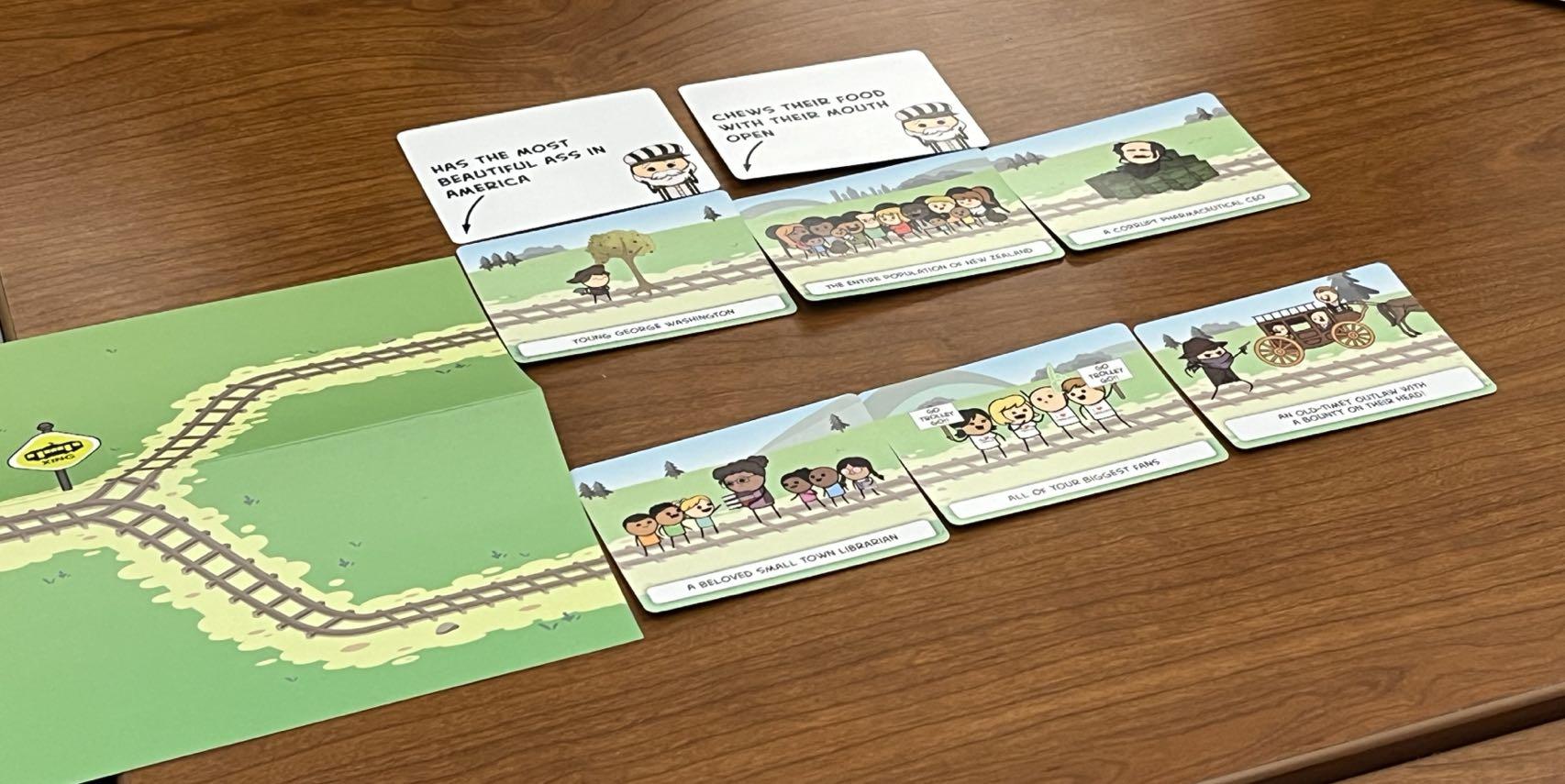Trial by Trolley is a team vs. team physical or online card game designed by Scott Houser and published by Skybound Tabletop. The game targets 3-13 people ages 14+. I played the game on the game night with a group of 7 players.

Central Argument
Judging in this game fosters fellowships by enabling players to disclose their preferences and find similarities among players through the narratives of and challenged by the antimoral decisions to make. The procedure of the game of selecting and defending antimoral actions to murder a group of people on one trial enhances the narratives as the players need to make up stories about why people on one trial are more “deserved” to die compared to those on the other trial. Judging takes part here when the conductor needs to choose which team to win based on his/her preferences and the narratives of the two teams. In this process, to compel the conductor, the teams need to understand his/her preferences and make stories aligned with the preferences. Similarly, when selecting cards of people to put into the trials, the teams need to guess or ask to judge the conductor’s preferences. During this process, the players disclose and understand each other’s preferences and could find similarities among themselves, fostering the fellowship.
Analysis
Based on the procedure of the game, the team members are involved in judging all the time, promoting disclosure of preferences and helping them to find similarities among them. When selecting cards to put onto the trials, they judge themselves by sharing and understanding each others’ ideas during discussion. The team members might find similarities among each other during this stage. For example, my teammates and I found the card with “a 10-year-old child earning way more money than I” to be fun and considered “guilty” to put on the other team’s trial and found that we have the similarities of loving money. At the same time, they are judging the conductor’s preferences to compel him/her to “murder” the people on the other trial. For example, we asked questions to conductors such as “Do you like the money?” and “Do you like children?“, and we also learned more about the conductor’s preferences. Vice versa, during the card selection stage, the conductor is judged by the team members and judges each team’s choice when deciding which trial to “murder“. Throughout this process of judging each other’s preferences, all players have the chance to disclose and learn each other’s preferences, identities, and characteristics.
Players are more likely to show their instincts and enjoy the game when judging ridiculous narratives that enhance friendships as the game is distinctive from others due to its antimoral pattern involving “murdering”. The mechanism of the game defines that the final decision is solely based on the conductor’s personal choice and preferences. This setting enables the players to disclose their preferences more compared to other games when making decisions. For example, when making decisions as a conductor, I saved one trail because there was a rainbow and I would receive tons of money if I saved the trail, and all the other players understood that I love fantasy and money even more than children. The mechanism and premise of this game put the players in an anti-social and anti-moral situation to encourage players to disclose their identity and characteristics more than other games. At the same time, the story and cards of the game including fantasy and scenes such as hell deviate enough from reality to make the players immersed in this game without references to real life, enhancing their imagination for narratives. During our game, we also have fun when hearing and judging each other’s stories about why some groups are guilty, which also brings dynamics to the game when each player is making creative and ridiculous stories.
However, due to this unique anti-moral premise of the game, it might be less fun than expected when playing with strangers for the first few rounds. This is because people tend to hide the evil side of their identities and characteristics from strangers, hesitating to disclose their true preferences. In this way, there are fewer discussions than expected, reducing the fun of judging narratives and not enhancing friendships. that I think some recommendations would be trying to promote discussion such as indicating in the rules about what players could do at each stage. For example, the rule can remind the players to ask for the conductor’s preferences during the card selection stage. Besides, maybe more cards could deviate further from reality, such as cards involving fantasy and fairytales, so that the players will be more immersed in the game and might be willing to disclose their choices as the deviation from reality might make the player feel safer when sharing information.
At the same time, like other card games, this game also involves luck when drawing the cards to put on the trial, which would determine whether the game would be fun or not, and the imbalanced power of the cards might make the game less fun. In one round of play, our team did not get compelling cards while the other team drew two cards that put both U.S. and New Zealand on the trail. This made the game less fun for our team as we found even with the strongest modifier card we had, it was unlikely that the conductor would save our trail. Also, during our play, we found that although we drew 3 cards at a time, there was often a card that was stronger than the other two in common sense and conductor’s preferences so our team did not discuss a lot to reach an agreement on which card to use. This makes the players less likely to share information with each other and enjoy less fun from narrative and judging. Also, during our play, the conductor was less involved in the card selection stages as there are seldom two cards that are truly at a tie that needs to be broken by the conductor’s preferences. So, the conductors were less involved in the card selection stages and had less fun compared to other players. I think maybe the designer could let the players draw more cards to select from and also design more carefully to find the balances among the cards although it is hard to do so and the current version is already enjoyable with its mechanism and unique premise.



